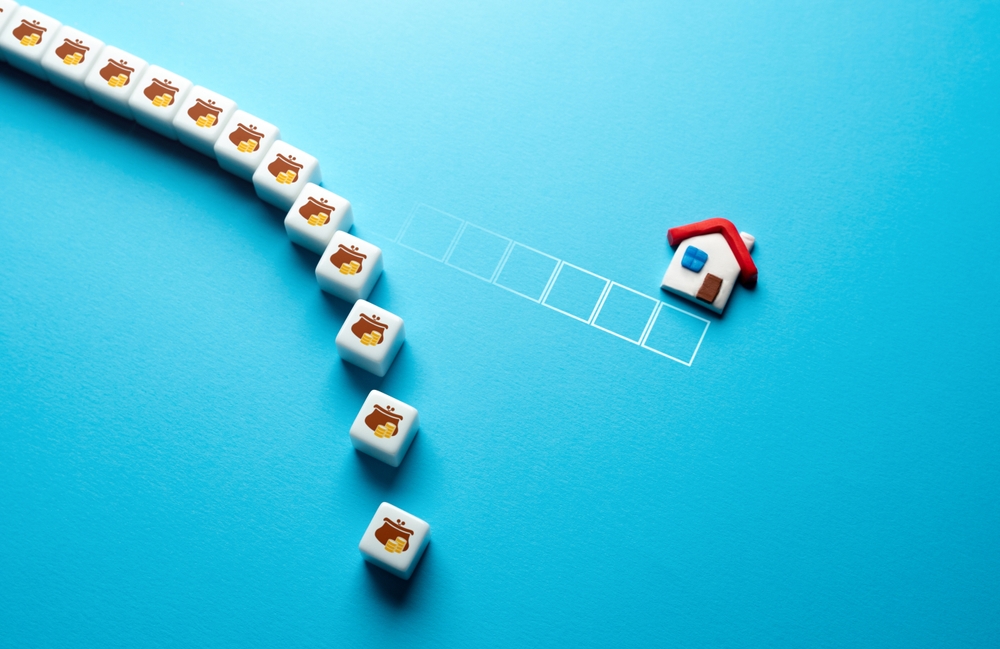Over the past few years, the U.S. housing market has felt remarkably inconsistent. One month there’s no better time to buy a house (RIP low-interest rates), but wait just a little too long and all of a sudden it’s the worst possible time to buy. There are always going to be positives and negatives when it comes to timing the purchase of a home, but you may be in a position where you want to save up so that you’re ready to decisively purchase in five years.
The elephant in the room is the tall order of saving up for a down payment in this housing market. Here are some tips to guide you on your savings journey, based on the average down payment for a home and the typical salary across the country.
What Is a Down Payment?
A down payment is a cash deposit that’s put toward the purchase price of a home. It shows you have some skin in the game, so to speak, and helps lenders at banks feel more comfortable offering you a loan for the balance of the purchase price.
According to the National Association of Realtors (NAR), in 2021 the average first-time homebuyer put a seven percent down payment on their home. The amount you have to put down can also depend on the type of mortgage loan you receive and can be as low as 3.5 percent. However, the traditional rule of thumb is to save 20 percent of a home’s sale price for a down payment. That’s the threshold that’ll likely make it easier for banks to work with you.
Keep in mind that a small down payment amount may be easier to save for, but your monthly mortgage payment will be higher. A larger down payment may take more time to save up for, but you’ll have a smaller amount to pay monthly.
Cost of an Average House vs. an Average Salary
The housing market has been notoriously volatile over the past few years, thanks to the COVID-19 pandemic, low-interest rates, rapid movement around the country, and the subsequent rising of interest rates.
According to NAR, by the close of the first quarter of 2023, the median price of a single-family starter home was $315,500. In 2022, the median age of first-time homebuyers was 26 years old. This means that if you’re inching toward your late 20s or early 30s, it may be time to start saving up for your eventual home.
For context, a 20 percent down payment for a $315,500 house is $63,100. Over five years, that equates to saving $12,620 per year, or about $1,051 per month. According to the U.S. Bureau of Labor Statistics, the median weekly earnings for full-time workers between 25 to 34 years old is $1,018 per week, or $52,936 annually.
That means that saving up for the median cost of a home in 2023 requires saving about 25 percent of your monthly income over the course of five years.
Market Variation
These metrics can shift substantially based on core details of your life, such as your salary and where you want to buy a home. However, the most important consideration to ponder as you begin to save is your own flexibility about where you want to live and what concessions you’re willing to make to save for that dream.
There’s a reason people often say first home. Your first home may not be perfect, but it’s a place to start deepening your equity so you can potentially pivot to a new location in the future. Buying high in a desirable area can pay off, but so can buying low in a developing area that may be easier to afford.
How Can I Save for a Down Payment?

A few strategic decisions can make saving $1,000 per month much easier than it sounds. Begin examining your budget and saving more money with the following steps.
High-Yield Savings Accounts
This isn’t as much about finding the money to save as it is about saving well. Let’s say you put $1,000 into a high-yield savings account today. Right now, the average return on high-yield savings is 4.2 percent annually, which shakes out to $42 in interest over the course of 12 months.
This may not seem like a monumental amount of money, but over the course of five years, that $1,000 may end up being worth $1,228.39 if you don’t remove it from the account and if the rate stays steady. Plus, the more money you save, the more your interest rate starts to compound, and you’ll earn interest on top of interest.
If you place your money in a high-yield savings account, you’re signing up for free money that benefits your savings goals. Plus, earning interest isn’t risky when compared to putting your savings into the stock market, and you’ll still get a solid return on your investment.
Align Your Lifestyle With Your Budget Without Relying on Credit
Spend some time reviewing the entirety of your monthly budget and mapping out where your money goes. You may be surprised to find habits like spending $1,000 a month on going out to restaurants, or spending more than your earned income regularly and subsidizing the rest on credit cards. If you’re subsidizing your lifestyle with credit, start to make a plan to pay down your existing debt and live within the means of your salary.
The average credit card interest rate is 24.52 percent, so if you carry a $1,000 balance over the course of a year, you’ll end up paying $245.20 more than your balance in interest. That $20.43 monthly bill may not seem that big, but it’s more expensive for you to use that borrowed money in the long run. It can go much further in saving toward your down payment.
Maximize Your Savings by Altering Habits
Once you have a way to review where your money goes with each paycheck, identify the areas where you spend the most money. In 2021, an analysis by Visual Capitalist found that Millennials spent 14.3 percent of their income on food and alcohol.
That comes out to $7,569.85 per year, or $630 a month. You obviously need to eat, and you shouldn't feel guilty about spending meaningful time with friends or family; however, you can make a small goal to reduce this monthly spending by, say, 25 percent over the year. That opens up $157.50 each month, or $1,890 over the course of a year.
Find a Side Hustle to Maximize Your Income
Your side hustle can take many different shapes, like walking dogs, babysitting, driving for a ride-share service, offering freelance services, getting a part-time job on nights or weekends, or flipping items like furniture or clothes via online platforms. The opportunities are endless!
Any side hustle you pursue could easily earn you an extra $500 per month outside of your salary. If you save that money directly, that’s half of what you need for your monthly down payment savings right there.
Consider Roommates
If you live alone and hear the word roommate, you may automatically shudder. But say you have a two-bedroom apartment that costs $1,500 per month — you could easily rent out your second room for about half that amount, which opens up $750 of your salary per month to reach your savings goals.
It’s not ideal for some and may not last all five years, but if you give the arrangement a try, you’ll have much more flexibility to save each month.
Is There a Way to Speed Up the Process?

While it’s disingenuous to generalize all potential homebuyers, there are key resources for first-time homebuyers that could be applicable to you, especially if you’re flexible about where you want to live.
For example, the Federal Housing Administration, which is a part of the U.S. Department of Housing and Urban Development (HUD), offers insurance on bank loans for as little as 3.5 percent for a down payment, which can help you buy your first home with a smaller amount of money saved. Your state may have its own mortgage program to help you reduce the amount of your down payment and get you into your first home.
Other programs to be aware of are HUD’s Good Neighbor Next Door, which cuts the sale price of homes in defined revitalization areas by up to 50 percent for firefighters, K-12 teachers, police officers, and other public servants.
Whether you’re looking to save up 3.5 percent or 20 percent of your down payment, building the habit of regularly saving is the first step to making that dream a reality.


